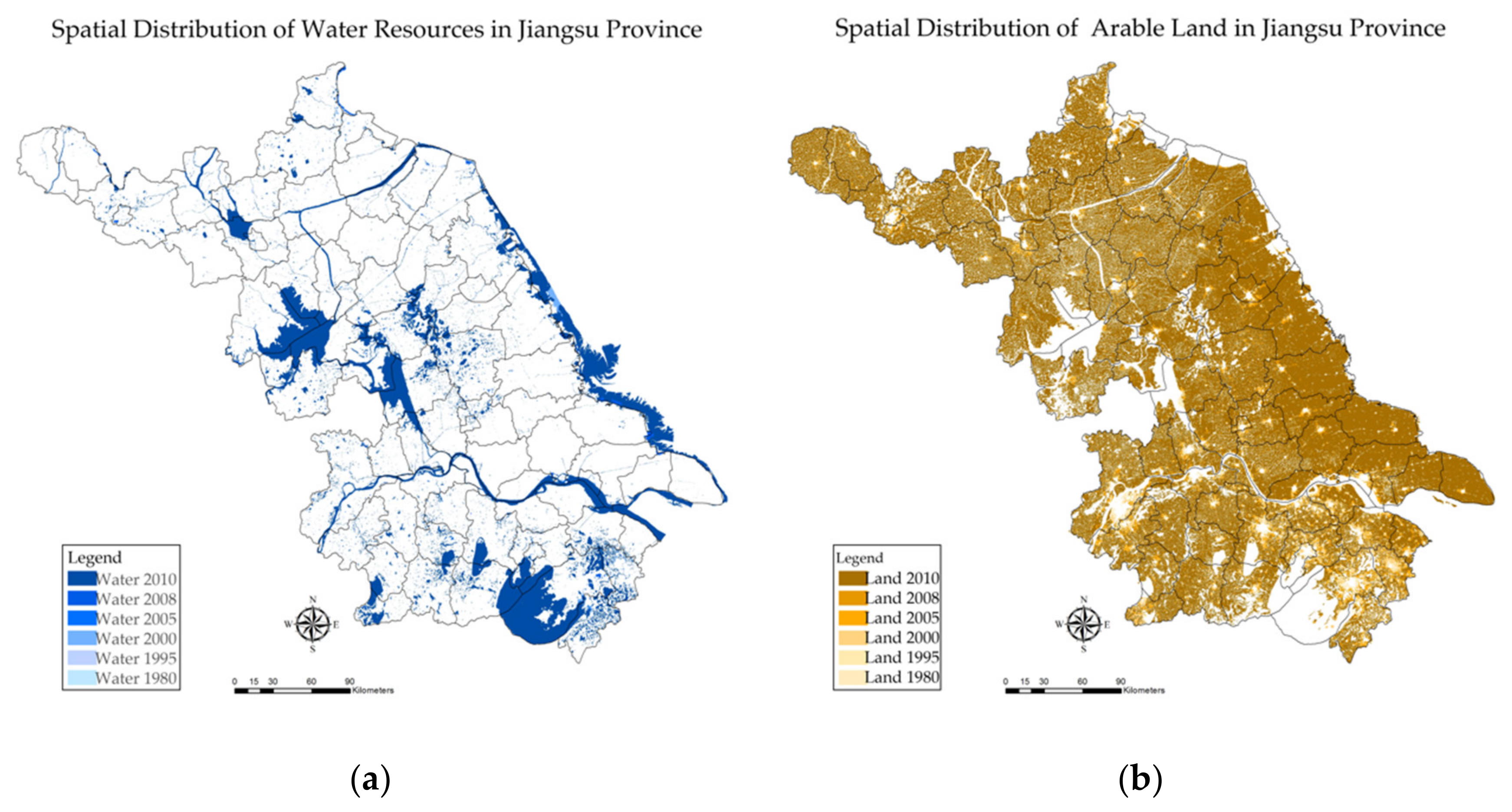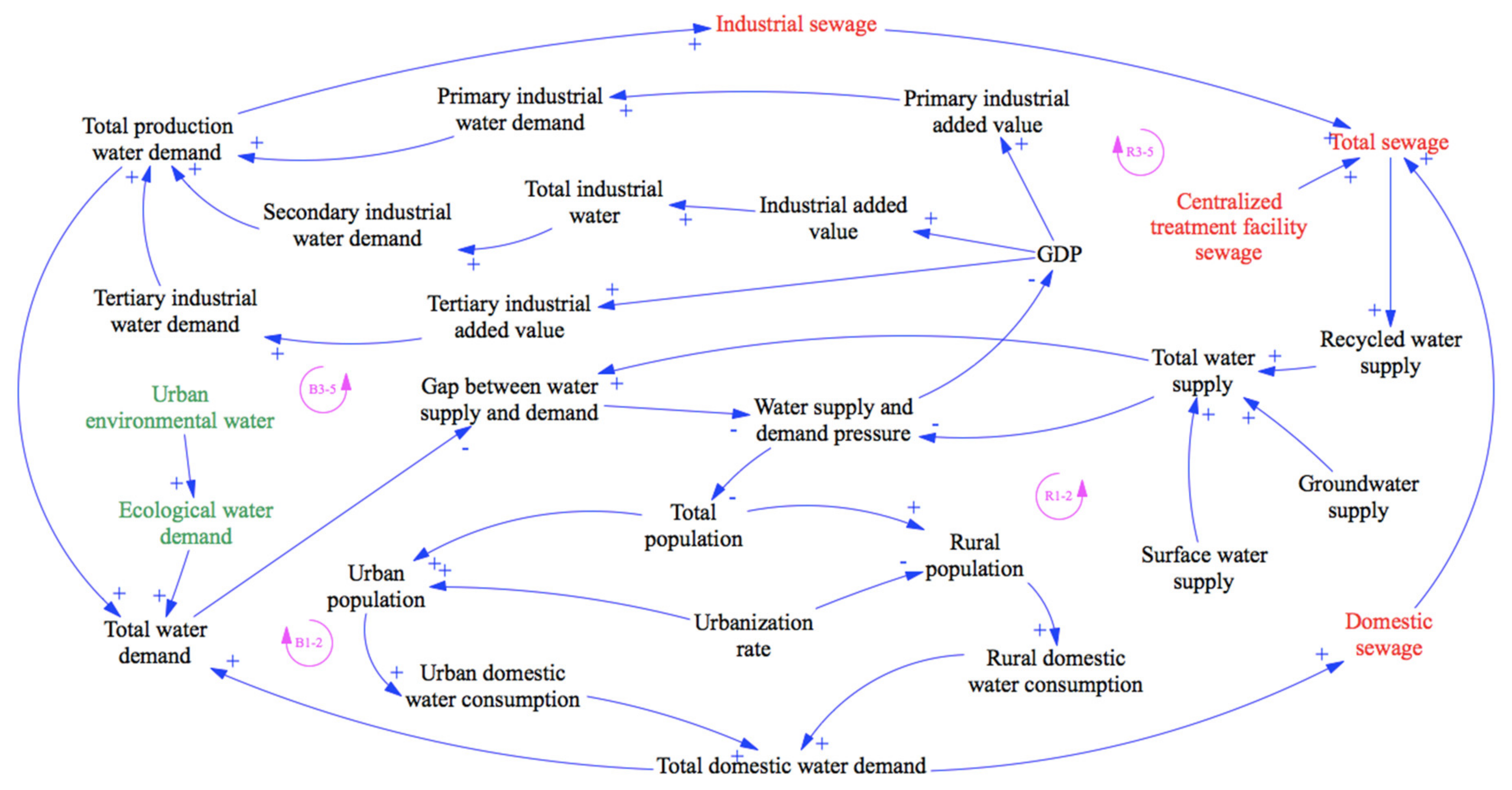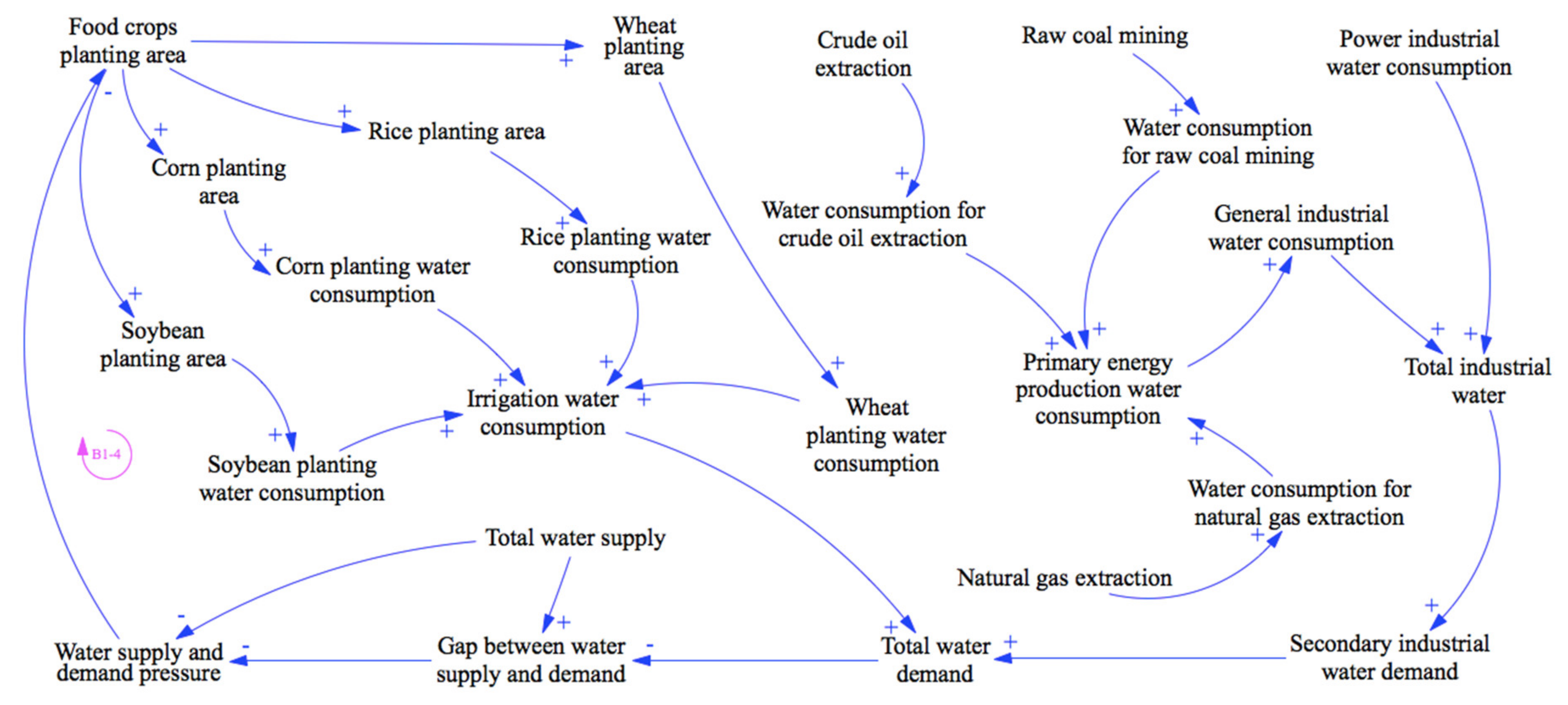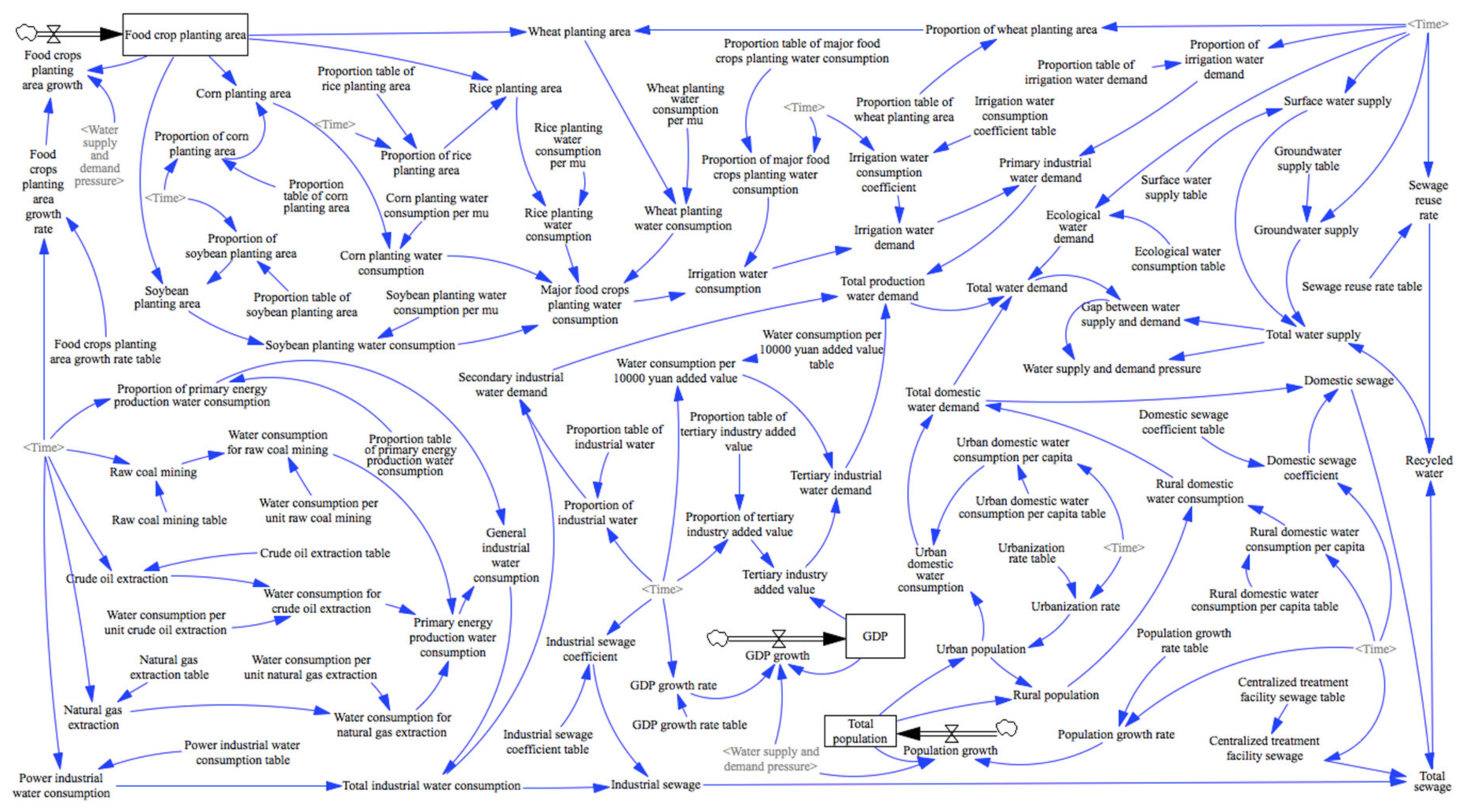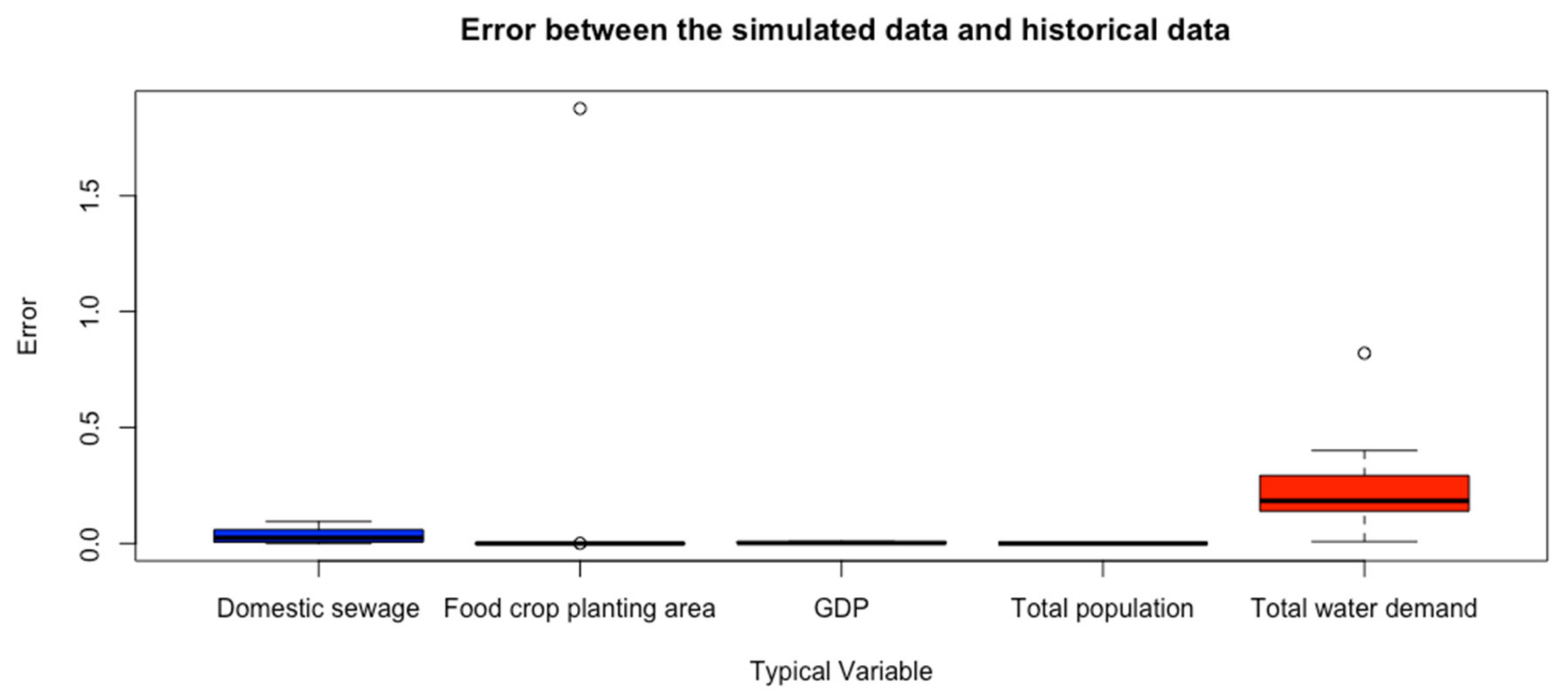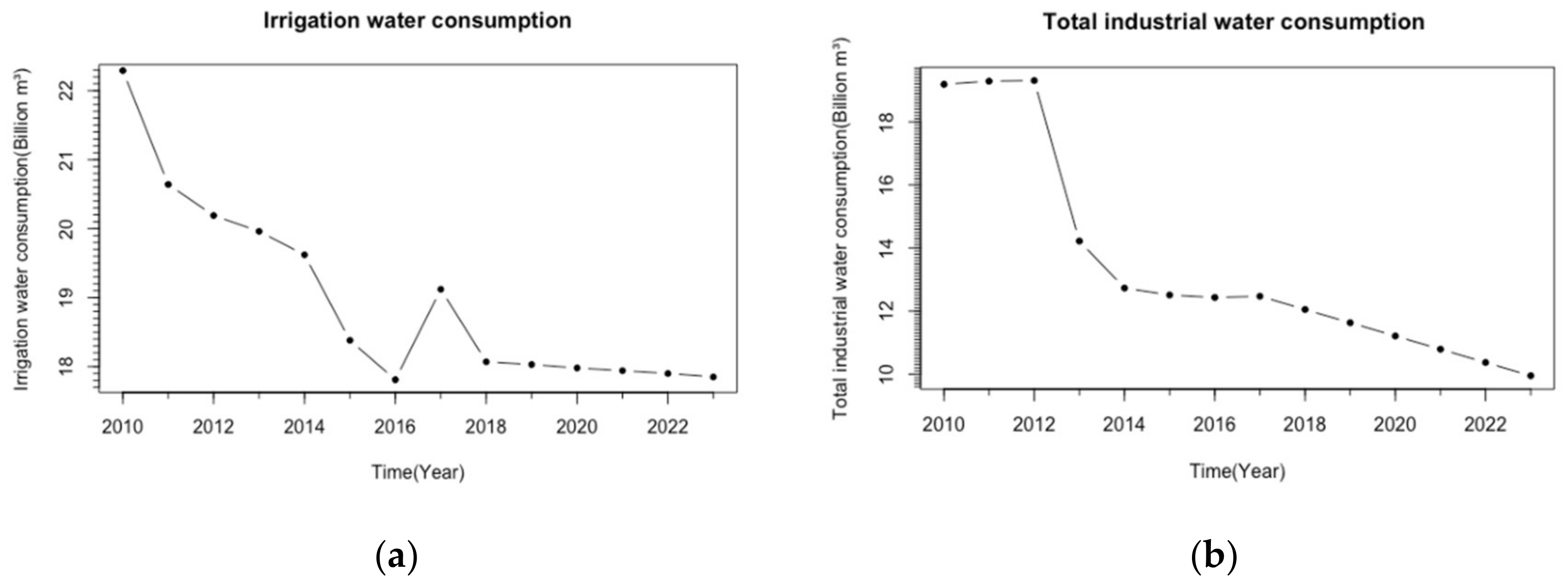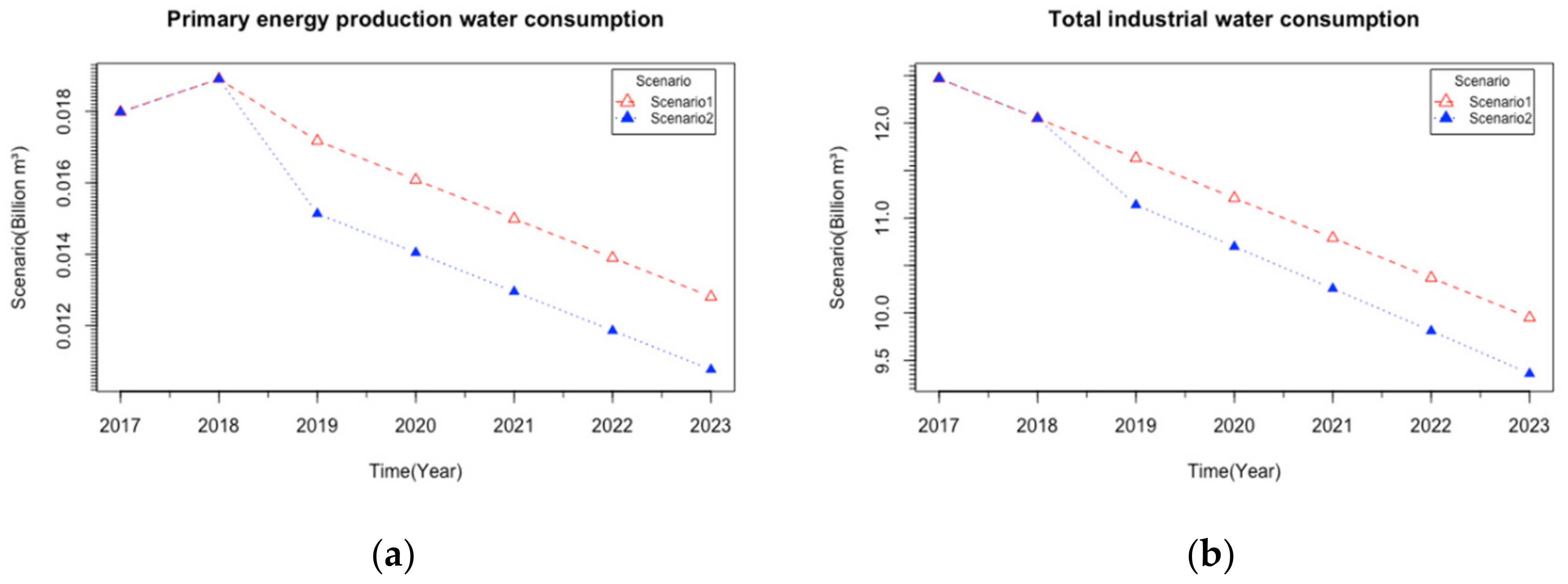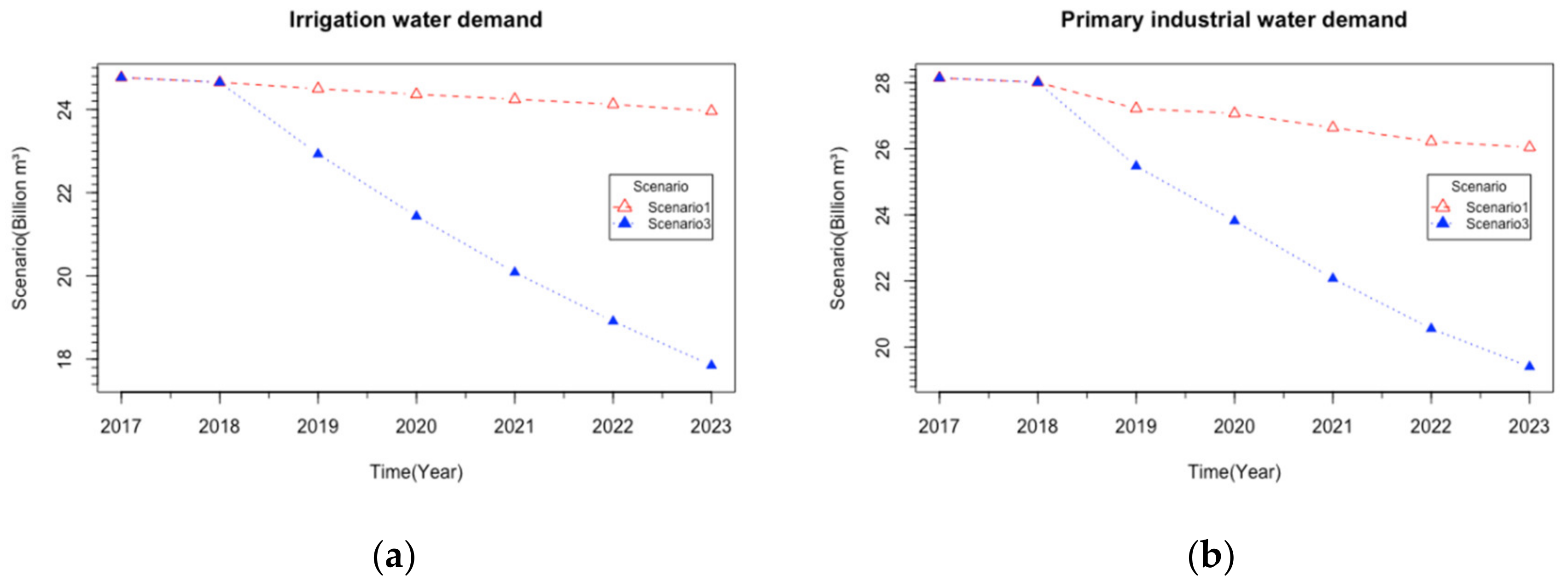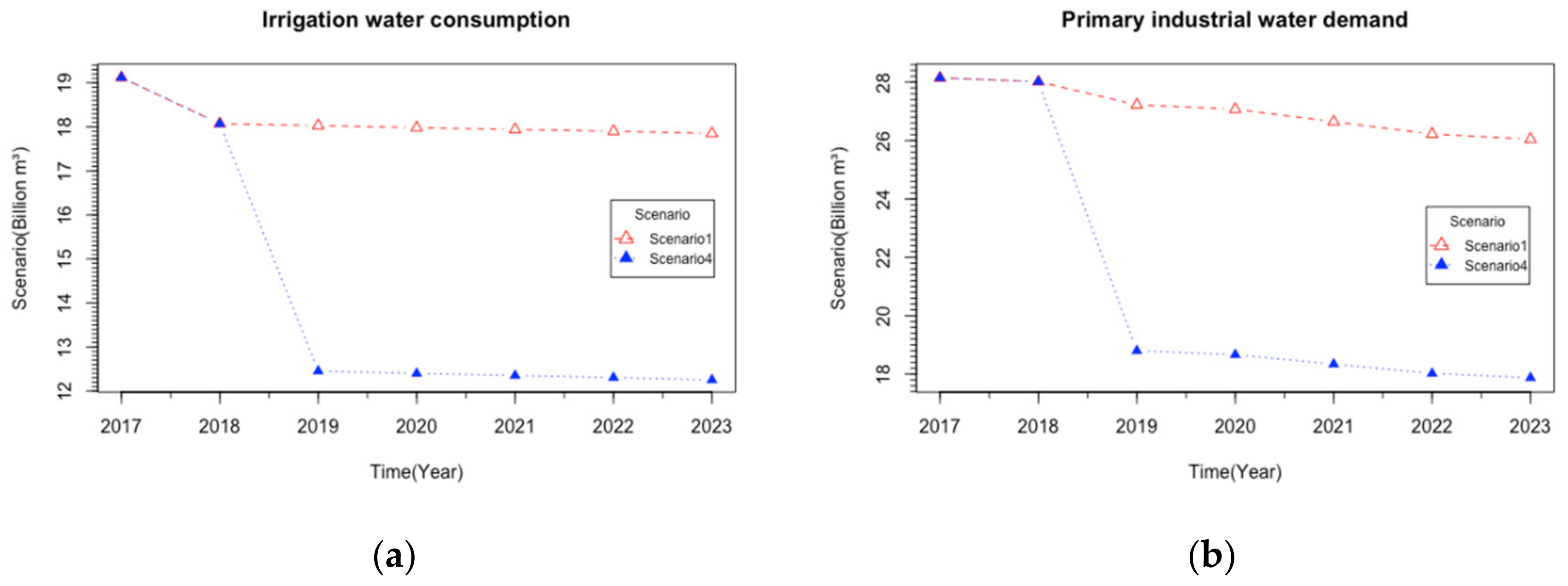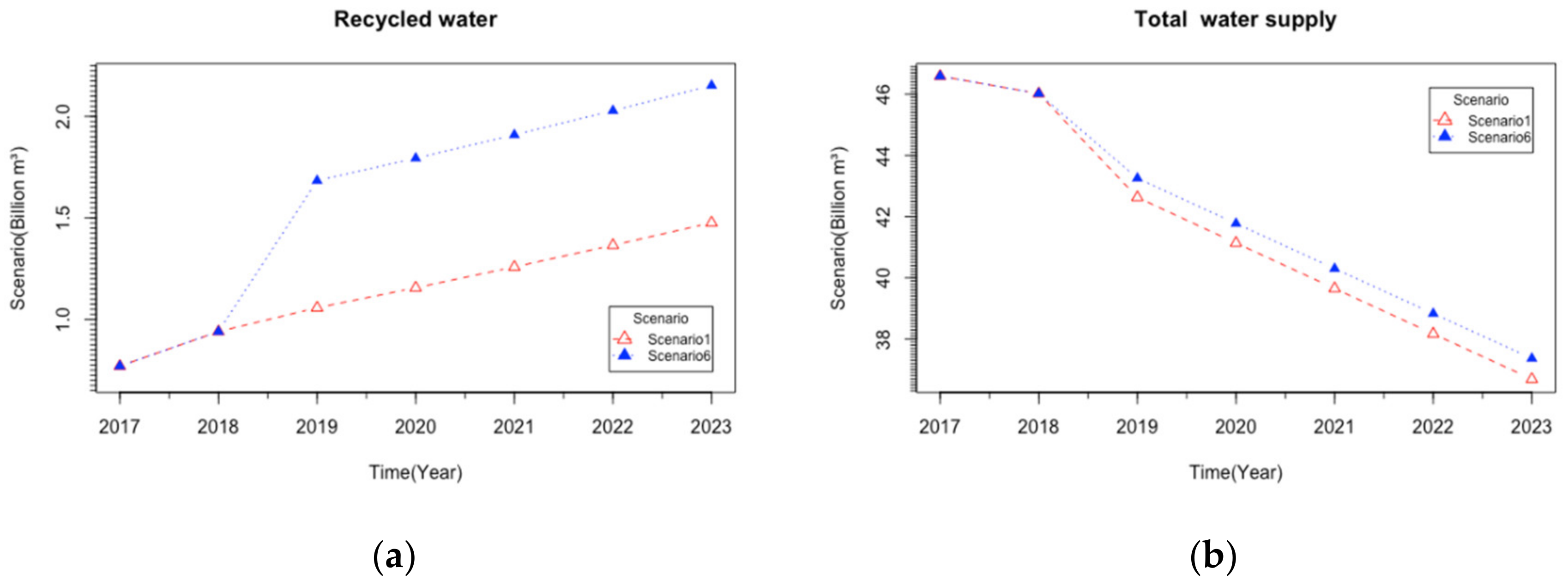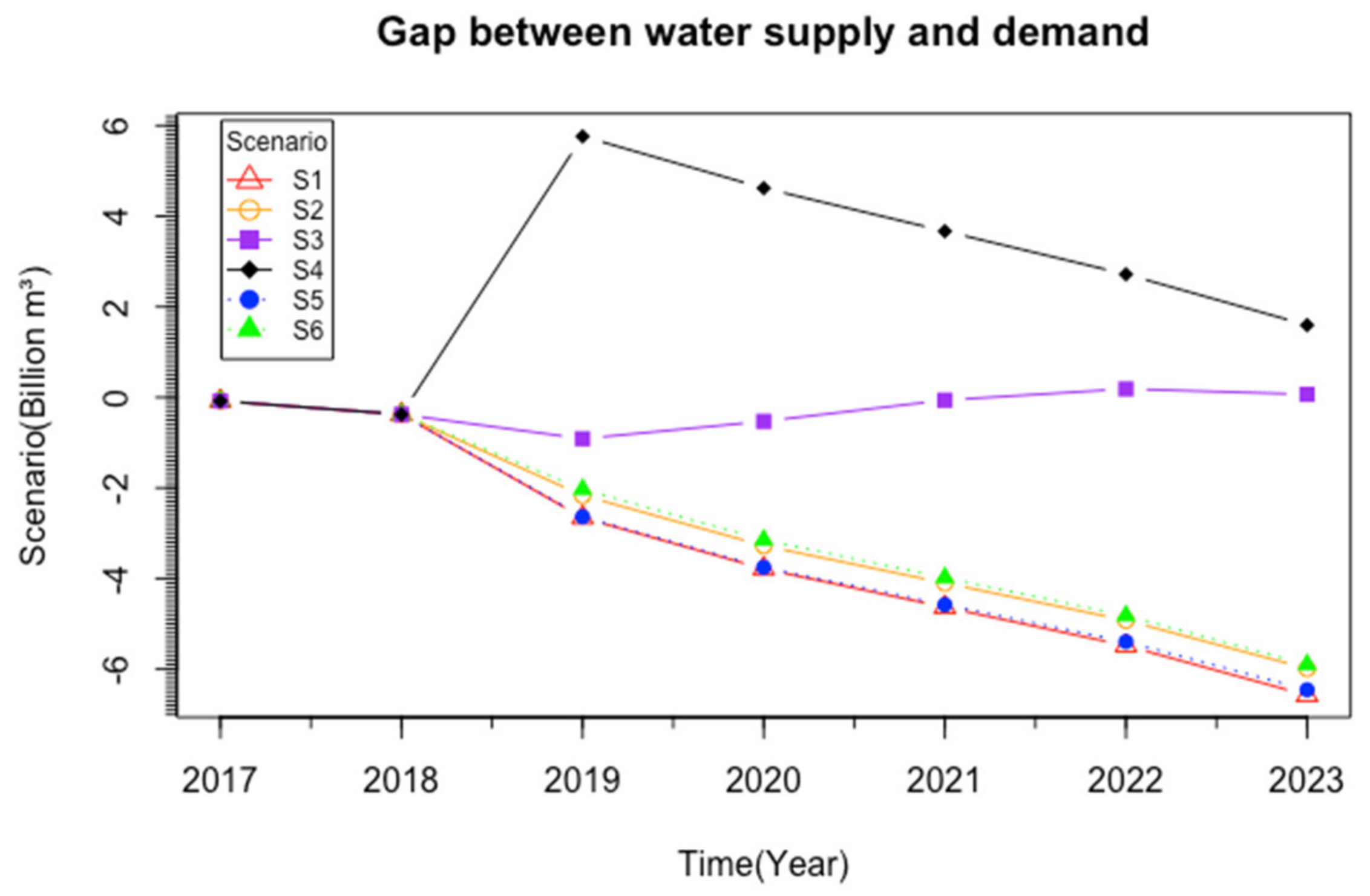1. Introduction
Water, energy, and food are important basic resources for the survival and development of human beings, and they are also necessary conditions and important supports for the sustainable development of society. Water resources are also an important part of the environmental system. There is a close and intricate relationship among water, energy, and food; they coordinate with each other to form a multi-variable coupling, reciprocal, dynamic system, and the coordinated development of them will play a positive role in human survival and development under the widely accepted background of global warming, which is associated with climate change and vegetation phenology [
1]. However, as a province that has abundant water resources, consumes a large quantity of energy, and also is a major food-producing region, Jiangsu Province has faced an increasingly serious problem of imbalance in the supply and demand of water resources under the influence of discordant development of the water–energy–food nexus in the context of population growth, resource shortages, and environmental degradation. To be specific, the total amount of water resources in Jiangsu is abundant, whereas the utilization rate for water resources and water quality are not high, and the per capita share of water resources are not large, which in turn leads to an aggravation of the contradiction between the supply and demand of domestic water. Moreover, large amounts of water are consumed in the process of energy production and food irrigation, which also deepens the imbalance of water resources in Jiangsu. Therefore, it is particularly important to alleviate the contradiction between water supply and demand in Jiangsu and maintain the balance between water supply and demand on the basis of effectively coordinating the relationship between water, energy, and food.
Current research on the dynamic and balanced development of regional water resources are generally conducted in terms of total amount management, water supply capacity, water resources allocation, and sustainability of water supply and demand. With respect to total water resources management, a dynamic equilibrium model to control the total amount of water resources was used to carry out research on the dynamic balance management of water resources [
2]. With respect to water supply capacity, the principle of the three supply and demand balances of water resources was applied to solve the problem of the imbalance between water supply and demand [
3]. With respect to water resources allocation, the problem of water supply-and-demand balance can be solved by rationally optimizing the allocation of water resources. Specifically, some methods like prospect theory, two-stage stochastic programming method, and improved grey prediction theory were used to optimize the allocation of water resources [
4,
5,
6]. Additionally, some studies focused on agriculture and analyzed the regional agricultural water resources supply–demand balance to improve irrigation water consumption efficiency [
7]. In addition, some studies focused on the ecological environment and studied the imbalance of water resources encountered in sustainable urban management [
8]. With respect to the sustainability of water supply and demand, some studies estimated the sustainable level of water supply and demand for planning the water system in preparation for future development [
9,
10]. What is more, many studies chose specific industries as research objects and studied their dynamic balance of water supply and demand [
11,
12]. Among them, there is a study linking water resources to energy and food, and it analyzes the sustainability of energy and water use during food production based on the optimal allocation of agricultural irrigation water [
13].
In recent years, the concept of the water–energy–food nexus has been continuously enriched, and research into this nexus has gradually deepened. Many noted practical nexus modelling tools have been proposed, such as the water supply model, power generation and environment (WPE) model, agent-based modeling (ABM) framework, and water–energy–food (WEF) nexus simulation optimization (WEFSiM-opt) model [
14,
15,
16]. Current research on the WEF nexus is generally conducted in terms of efficiency analysis, coordinated development, risk control, and sustainable development assessment. With respect to efficiency analysis, the structural path analysis method and data envelopment analysis method were used to study the input–output efficiency of the WEF nexus to improve the efficiency of resource utilization [
17,
18]. With respect to coordinated development, analysis of the coupling and coordination degrees of the WEF nexus was carried out to measure the level of coordinated development of the WEF nexus, thereby optimizing its coordinated development capability and enhancing the coordinated security guarantee capability [
19,
20,
21]. With respect to risk regulation, technologies such as remote sensing and integrated resource management were used in safety and risk prevention of the WEF nexus to enhance its risk management and control capabilities [
22]. With respect to sustainable development assessment, a step-by-step methodological approach was proposed for sustainability assessment [
23].
It has been concluded that most of the research on the dynamic balance of water resources is mainly from a macro perspective or within a single industry. What is more, on the study of the balance of water resources, little consideration has been given to the inefficient use of water in different production activities and the necessity of synergy development between different industries. Given the above research, this paper was the very first work to analyze the coordinated development of the water–energy–food nexus and explore effective, relevant policies for the water used in energy and food production to maintain the balance between supply and demand. Therefore, with the aim of the dynamic balance of water resources, this paper fully considered the intricate connections between WEF and used the principles and methods of system dynamics to build a WEF nexus system dynamics (SD) model. To be specific, the WEF nexus SD model combined the external social system, economic system, and eco-environmental system and focused more on studying the specific supply and demand mechanism of water resources in each subsystem. After building the model, a simulation study on the different policies of dynamic balance of Jiangsu Province’s water resources was performed to explore effective relevant policies for increasing water supply and decreasing water demand to maintain the balance between supply and demand. In terms of study area, this study selected Jiangsu Province as the research object with the aim of exploring how to coordinate the relationship between water, energy, and food in economically developed regions, and exploring how to make their water resources balanced so as to better promote the efficient use of resources and the sustainable development of the society and economy.
3. Simulation and Results
This study set up six different scenarios for simulation research on the dynamic balance policies of water resources. The design ideas of each scenario are shown in
Table 3. To sum up, scenarios 2, 3, 4, and 5 are from the perspective of decreasing water demand by savings on energy production water consumption, food production water consumption, and domestic water consumption, whereas scenario 6 is from the perspective of broadening water sources to increase water supply.
3.1. Scenario 1
This scenario analyzed the water supply and demand in Jiangsu in the next five years if the current development trend is maintained. This scenario chose 2019 as the base year for the system model prediction, chose 2019–2023 as the simulation period, and used the SD model to predict the development trend of the WEF nexus. With respect to method, this paper used a double-exponential model with good short-term forecasting ability, which is also called Holt index smoothing in R language software, to predict the values of all input variables during the simulation period, which were inputted to the Vensim software to perform the WEF nexus system dynamics simulation.
Simulation results of scenario 1 are shown in
Figure 8. In the next five years, the province’s irrigation water demand, total industrial water consumption, and ecological water demand will all decrease year by year. In contract, tertiary industrial water demand and total domestic water demand will increase year by year. Overall, the total water demand will be in a downward trend. However, the continuous reduction in the surface water and groundwater will lead to a decrease in the total water supply year by year, which will make Jiangsu Province face the risk of a shortage of water resources in the next five years, and the gap between water supply and demand will grow.
3.2. Scenario 2
This scenario considered promoting the energy utilization of straw to save on water production for energy production. In this scenario, straw crops are turned into biomass energy to replace the original traditional fossil energy; however, there must be enough straw returned to the field to ensure that the soil fertility of crops is not reduced. This method can reduce the amount of water used in energy extraction and production so as to achieve the purpose of saving industrial water.
The scenario design process was as follows: According to the data released by the Jiangsu Science and Technology Department, the comprehensive utilization rate of straw in Jiangsu Province reached 92% in 2017. Therefore, in this scenario, the comprehensive utilization rate of straw in Jiangsu Province from 2019 to 2023 was assumed to be 100%, that is, all straw would be effectively used. Then, the part of the increase in straw resources caused by the increase in the comprehensive utilization rate of straw was all used for energy. The data processing was as follows: Bsased on the food crop straw/grain ratio calculated by Liu and conversion factors from physical units to coal equivalent of various energy given in the “Chinese Energy Statistical Yearbook”, standard coal equivalents converted from various straw crops in Jiangsu were calculated [
37]. In addition, conversion factors from physical units to coal equivalent of straw crops other than soybean, cotton, corn, rice, and wheat were calculated according to the fireweed’s conversion factors from physical units to coal equivalents. Taking the food crop production of Jiangsu Province in 2018 as a reference, it was calculated that increasing the comprehensive utilization rate of straw in Jiangsu Province from 92% to 100% could increase the standard coal equivalents converted from various straw crops by 1941390.487 tce. Then, this part of the biomass energy would be solidified into fuel to replace the raw coal for thermal power generation, because the biomass solidification molding process does not consume water. It was calculated that this can save 2.7179 million tons of raw coal. In this scenario, the data of the SD model made the adjustment that the amount of the raw coal mining in the simulation period was reduced by 2.7179 million tons.
Scenario 2 simulation results are shown in
Figure 9. Compared with the scenario 1 simulation results, the water consumption of primary energy production in Jiangsu will decrease from 0.1281 m
3 to 0.1077 m
3 by 2023. To conclude, using biomass energy as a renewable energy source to replace non-renewable energy from raw coal for thermal power generation can reduce the amount of raw coal mining so as to reduce the amount of water consumption for raw coal and then reduce the amount of water consumption for primary energy production and total industrial water consumption in Jiangsu.
3.3. Scenario 3
In this scenario, the irrigation water consumption coefficient was selected as the decision variable for regulating and controlling irrigation water demand, and the value of the irrigation water consumption coefficient was increased to reduce the irrigation water demand. What needs to be explained is that the irrigation water consumption coefficient is the ratio of water that cannot return to surface water bodies and underground aquifers during irrigation and transportation due to gross irrigation water consumption. The higher the irrigation water consumption coefficient, the higher the utilization rate of farmland irrigation water. When the irrigation water consumption coefficient reaches 1, there will be no unnecessary loss of water resources in the process of farmland irrigation water delivery and water consumption, which is the most ideal state of irrigation. Therefore, in this scenario, it was assumed that the optimal state of farmland water-saving irrigation could be reached in 2023, and the irrigation water consumption coefficient was increased by 0.0534 year by year during the 5 years from 2019 to 2023.
Scenario 3 simulation results are shown in
Figure 10. Compared with the scenario 1 simulation results, by 2023, the irrigation water demand will decrease from 23.9593 billion m
3 to 17.85 billion m
3. In addition, primary industrial water demand will decrease following the change of irrigation water demand. To conclude, the utilization rate of irrigation water can be improved by increasing the irrigation water consumption coefficient to reduce the irrigation water demand and alleviate the water supply pressure in Jiangsu Province.
3.4. Scenario 4
In this scenario, the proportion of rice planting area, the proportion of wheat planting area, and the proportion of corn planting area were selected as the decision variables for regulating and controlling irrigation water consumption. With the expected ultimate purpose of reducing irrigation water consumption, this scenario considers adjusting the food crops planting structure according to the actual situation of food crop cultivation in Jiangsu Province.
The scenario design process was as follows: According to Xue’s research on the relationship of major food supply and demand in Jiangsu Province, it can be found that food supply in Jiangsu has generally been in a state of supply exceeding demand in recent years [
38]. Specifically, the supply of rice and wheat has exceeded demand, whereas corn is in short supply. Additionally, according to the water consumption per unit mass of the main food crops in China, the order of the water consumption per unit mass of rice, wheat, corn, and soybeans is soybean > wheat > rice > corn [
39]. Based on the above facts, the food planting structure was appropriately adjusted to reduce the irrigation water consumption. The rice planting area and wheat planting area were appropriately reduced, and the lands vacated by these adjustment were used for corn planting, which has relatively small water consumption, ensuring enough supply of water to rice and wheat. It is worth mentioning that the planting area of the other food crops remained unchanged in this scenario because of low proportion. Combined with Xue’s research data, this scenario sets the ratio of the food crop planting structure in the SD model simulation period as rice area/wheat area/corn area = 19:21:54.
Scenario 4 simulation results are shown in
Figure 11. Compared with the scenario 1 simulation results, by 2023, irrigation water consumption will decrease from 17.8497 billion m
3 to 12.252 billion m
3. In addition, primary industrial water demand will decrease following the change of irrigation water consumption. To conclude, the irrigation water consumption can be effectively reduced by a reasonable adjustment of the food crop planting structure in Jiangsu, so that the primary industrial water demand is reduced, and the water supply pressure in Jiangsu can be effectively relieved.
3.5. Scenario 5
For the expected ultimate purpose of saving domestic water, this scenario selected the population growth rate, urbanization rate, rural domestic water consumption per capita, and urban domestic water consumption per capita as the decision variables for regulating and controlling total domestic water demand. According to the “Jiangsu 13th Five-Year Plan for Population Development”, the urbanization rate of Jiangsu will continue to slow down during the “13th Five-Year Plan” period, and the population urbanization rate will increase by about 0.6 to 0.8 percentage points annually. Therefore, this scenario set the annual growth rate of the urbanization rate during the simulation period as 0.6 percentage points. In addition, this scenario assumed that all residents in Jiangsu use water resources strictly in accordance with the resident domestic water quota. The quota of urban domestic water consumption per capita was set as 150 L/(person · day) and the quota of rural domestic water consumption per capita was set as 100 L/(person · day), which were obtained from the “Urban Life and Public Water Quota of Jiangsu Province (Revised in 2012)”.
The scenario 5 simulation results are shown in
Figure 12. Compared with the scenario 1 simulation results, the urban population decreased from 61.5837 million to 59.2182 million and the urban domestic water consumption also declined, which led to the decrease of the total domestic water demand in Jiangsu. Moreover, by 2023, the total domestic water demand will decrease to 4.05796 billion m
3. To conclude, requiring residents to strictly follow the water quota can effectively save the domestic water consumption.
3.6. Scenario 6
The expected ultimate purpose of this scenario was to increase the supply of water resources and enhance the supply capacity of water resources, the methods of which include improving the capacity of natural water resources development and utilization, improving the sewage reuse rate, and so on. Considering the availability of data, this scenario selected the sewage reuse rate as the decision variable for regulating and controlling the recycled water supply. Furthermore, this scenario increased the supply of water resources by converting more domestic sewage and industrial sewage to water that meets certain quality standards and can be used at certain occasions. With respect to the data processing, this scenario referred to the data from the “Thirteenth Five-Year Plan for National Urban Sewage Treatment and Recycling Facilities Construction Plan”, which set the following goals: The water utilization rate of the Beijing-Tianjin-Hebei area is not less than 30%, the water utilization rate of water-scarce cities is not less than 20%, and other cities and counties strive to reach 15%. According to the goals above, in this scenario, it was assumed that a sewage reuse rate of Jiangsu Province of not less than 30% can be reached in 2023. Therefore, this scenario’s data processing was as follows: The annual sewage reuse rate was increased by 10 percentage points based on the data of scenario 1 during the 5 years from 2019 to 2023. Then, the sewage reuse rate of Jiangsu Province in 2023 will reach 31.8217%, which will meet the hypothetical goal.
The scenario 6 simulation results are shown in
Figure 13. Compared with the scenario 1 simulation results, the total water supply of Jiangsu will increase from 36.689 billion m
3 to 37.3654 billion m
3 by 2023, caused by the increase of the recycled water. To conclude, increasing the sewage reuse rate can effectively increase the water supply, so that the water shortage of water resources in Jiangsu will be alleviated.
4. Discussion
This study explored effective ways to achieve a dynamic balance of water resources by setting up six different scenarios from the perspective of increasing water supply and decreasing water demand. This paper selected the gap between water supply and demand as the state variable to measure the dynamic balance of water resources in Jiangsu. If the gap between water supply and demand is positive, supply exceeds demand, otherwise, supply exceeds demand. The comparison of the simulation results of the gap between water supply and demand in the six scenarios are shown in
Figure 14. To conclude, the results show that the imbalance of water resources will remain severe in the next few years, and it will be helpful in relieving the imbalance to take measures from the perspectives of regulating the water consumption from food production, energy production, and domestic water consumption, and regulating the water resource supply. According to the above analysis, some suggestions about regulating and controlling water supply and demand are included.
4.1. Regulation and Control of Water Consumption for Food Production
Compared with the other scenarios, scenarios 3 and 4, which both aim to save water consumption from food production, have the best effects of relieving the contradiction of water resources supply and demand in Jiangsu. Scenario 4 adjusts the planting structure of food crops, the gap between water supply and demand becomes positive, and the situation of supply exceeding demand emerges. To conclude, increasing the effective utilization rate of irrigation water and appropriately adjusting the food crop planting structure can effectively reduce the water consumption from food production and alleviate the pressure of water supply in Jiangsu Province.
According to the above analysis, some suggestions about regulating and controlling the water consumption for food production are put forward. Firstly, in terms of agricultural water conservancy projects, Jiangsu Province needs to strengthen the construction of agricultural water-saving projects and improve the farmland water conservancy infrastructure, etc. Secondly, in terms of water-saving technologies, Jiangsu Province needs to promote high-efficiency water-saving technologies such as agricultural water sprinkler irrigation, seepage irrigation, drip irrigation, micro irrigation, inrush irrigation, gravity irrigation, and dry–wet alternate irrigation, etc., and deepen the research and promotion of agronomic water-saving and bio-physiological water-saving technologies to improve the irrigation water consumption coefficient so as to reduce unnecessary water loss during irrigation. Thirdly, in terms of the food planting structure, according to the actual food demand and irrigation water demand in Jiangsu, the planting of crops that consume a lot of water in the process of planting should be appropriately reduced and replaced by crops that consume less water. Last but not least, in terms of a management system, the quantitative management of irrigation water demand should be strengthened, and the “Jiangsu Agricultural Irrigation Water Quota” should be constantly adjusted and improved according to the latest development of farmland irrigation in Jiangsu so as to guide agricultural production more accurately. In addition, agricultural water price management mechanisms should be established and improved.
4.2. Regulation and Control of Water Consumption for Energy Production
The effect of relieving the contradiction of water resources supply and demand in Jiangsu made by scenario 2, which aims to save water consumption from energy production, is not as good as scenarios 3 and 4. However, the positive effects of reducing the water consumption for energy production and water resource pollution by replacing traditional energy with eco-friendly biomass energy are still obvious.
According to the above analysis, some suggestions about regulating and controlling the water consumption for energy production are put forward. Firstly, in terms of fuel and gas production, the production of biomass solid-shaped fuel and biomass gas that does not consume water in the production process should be actively promoted. The energy utilization of straw crops also should be promoted. Straw resources can be gasified into high-value biomass gas by pyrolysis gas and other technologies. Furthermore, straw resources solidified and compressed into shaped fuel by related mechanical equipment and the solidified and compressed straw can be further carbonized to increase the calorific value of straw fuel. Secondly, in terms of secondary energy power production, Jiangsu Province should strive to develop air-cooling technology and build high-capacity and high-parameter units to gradually ban DC direct cooling thermal power generation, which consumes a large amount of water. Due to the coastal advantage, the nuclear power generation industry should be actively developed so as to reduce the use of freshwater resources in the power generation process. In addition, Jiangsu Province should continue to develop wind power and solar power industries and increase the development of biomass power generation industries so as to use biomass such as straw crops, domestic waste, and biogas to generate electricity.
4.3. Regulation and Control of Domestic Water Consumption
In the next few years, domestic water consumption and industrial and domestic sewage discharge will rise. Compared with other scenarios, scenario 5, which aims to save domestic water consumption, has a small effect on relieving the contradiction of water resources supply and demand in Jiangsu. Obviously, the task of saving domestic water and controlling water pollution is arduous.
According to the above analysis, some suggestions about regulating and controlling domestic water consumption are put forward. Firstly, Jiangsu Province should establish a water-saving and pollution-proof society, ensuring the quality of water resources does not decrease and the safety of drinking water for residents is guaranteed. Relevant authorities should also strengthen water-saving publicity work to raise residents’ awareness of water-saving and reducing unnecessary water pollution and waste of water resources in ordinary life. In terms of system construction, the strictest management system should be implemented in the process of water resources management, the accountability mechanism for supervision should be established and strengthened, and the transformation from qualitative management of water resources to quantitative management of water resources should be promoted. What is more, water consumption quota standards such as “Urban Life and Public Water Quota” and pollution discharge standards such as “Village Domestic Wastewater Treatment Water Pollutant Discharge Standards” should be constantly adjusted and improved to better assist the public in scientifically formulating water pollution prevention plans so as to put water and pollution prevention work into the whole process of life and production of urban and rural residents. Last but not least, it is necessary for Jiangsu Province to optimize the industrial layout and strictly control the industries or enterprises with high water consumption and high pollution that settle in Jiangsu.
4.4. Regulation and Control of the Water Resources Supply
The above analyses looked at how to promote the dynamic and balanced development of water resources from the perspective of regulating and controlling water resources demand. From the simulation results of scenario 6, with the purpose of increasing the supply of water resources, it can be seen that proper development of water resources can alleviate the contradiction between water supply and demand in Jiangsu.
According to the above analysis, some suggestions about regulating and controlling the water resources supply are put forward. Firstly, it is necessary to strive to improve the sewage reuse rate, fully develop and use recycled water, and apply sewage recycling technology to the secondary industries like construction or agricultural production that do not have high requirements for production water quality. All methods mentioned above can recycle water resources and actively protect the ecological environment. Secondly, it is also necessary to strengthen the collection and reuse of rainwater and floodwater. Water storage projects such as reservoirs, rivers, and ditches should be constructed to improve the ability of saving rain and flood waters. In terms of mitigating the contradiction between urban development and the ecological environment, it is essential to pay attention to the collection and reuse of rainwater in buildings and to take some measures like improving the water storage space system in buildings and increasing the construction of multifunctional rainwater regulation and storage facilities. Last but not least, in terms of water resources management, it is essential to improve the development and utilization of surface water resources, and increase pollution control so as to improve the status quo of water resources and increase the amount of water resources available on the surface that meet the water quality standards.
5. Conclusions
With the aim of a dynamic balance of water resources, this paper used the principles and methods of system dynamics that can depict a complex relationship network to build a WEF nexus SD model that combined the external social system, economic system, and eco-environment system. In particular, this study focused on studying the specific supply and demand mechanisms of water resources in each subsystem. Then, this paper set up six scenarios for the simulation study: maintaining the current trend, promoting the energy utilization of straw, increasing the irrigation water consumption coefficient, adjusting the food crop planting structure, saving domestic water, and improving the sewage reuse rate.
Many conclusions can be drawn from our work. Firstly, the WEF nexus SD model, constructed by integrating the energy system and the food system on the basis of a single system of water resources and combining external social, economic, and eco-environmental systems, can be effectively applied to the analysis of Jiangsu’s water resources dynamic balance. Secondly, it is necessary to pay attention to the synergy of water, energy, and food during the study of the dynamic balance of water resources. This synergy is embodied in the results that show that using biomass energy can not only maintain energy security, improve the energy structure to alleviate the pressure of energy supply, and reduce the water consumption for energy production, but it can also in turn promote agricultural development and increase farmers’ income so as to make farmers be more willing to grow crops with higher efficiency and less water consumption, such as corn. It is worth mentioning that water consumption for agricultural production is decreased at the same time. Thirdly, taking no improvement measures of alleviating the water supply and demand contradiction and maintaining the current development trend of the WEF nexus will result in the consequence that Jiangsu’s water resources will not be able to achieve a dynamic balance, water shortages will occur, and the contradiction between supply and demand will gradually deepen. It is helpful for relieving imbalance to promote the energy utilization of straw, improve the irrigation efficiency, adjust the crop planting structure, require residents to strictly follow the water quota, and improve sewage recycling. Furthermore, simulation studies on the different policies of Jiangsu’s dynamic water balance from the perspective of the water–energy–food nexus is helpful for promoting the efficient use of resources and the sustainable development of the economy in Jiangsu, and they also have deep theoretical and practical significance.
There are some important contributions of this study. First and foremost, this study had a new research perspective that the dynamic balance of the water resources was studied from the perspective of the synergy of water, energy, and food, which further enriches the research perspectives on water resources balance based on the previous research [
2,
3]. Secondly, this study had an improved method of model establishment on that it not only combined a single water system with energy and food systems, but also fully integrated external systems such as social, economic, and eco-environmental systems. This improvement of the WEF nexus SD model was made on the basis of the water–energy–food nexus in Cyprus [
40]. Last but not least, this study had a new research object-screening method that centered on the water system and focused more on studying the specific supply and demand mechanism of water resources in the energy, food, social, economic, and eco-environmental systems, which is different from the study of the SD model WEF nexus in Beijing [
41].
However, the SD model itself is an abstraction and simplification of real problems. Because data are difficult to quantify and collect, many factors will be reduced in the process of building the WEF nexus SD model. This reduces the effectiveness of using system dynamics to solve practical problems.
